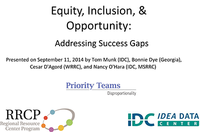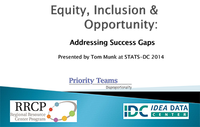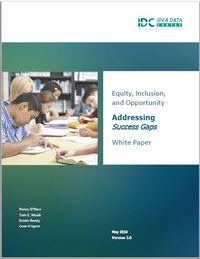The TA guide describes the methods a state might use to appropriately determine which of its districts has a significant discrepancy (including a significant discrepancy by race or ethnicity) in the rates of out-of-school suspensions and expulsions totaling greater than 10 days for children with disabilities.
After presenting a set of six basic rates, the guide presents a series of methods for determining significant discrepancy, giving a step-by-step example of the use of each method. For each method, the guide includes the question that the method answers, how to interpret its results, and related considerations. Before outlining and discussing the rates and methods, the guide identifies three factors that states must consider: minimum cell size requirements, racial/ethnic reporting categories, and the differences between the reporting requirements for B4B and significant disproportionality. Part B data managers and Part B coordinators are the primary target audiences for the guide.
Resource Files & Links
Related Content
Format: Presentations
Equity, Inclusion, and Opportunity: Addressing Success Gaps via the SSIP ProcessPresenters introduced a research-based guidance document and self-assessment rubric designed by OSEP's Disproportionality Priority Team to help districts and schools identify the root causes of "success gaps" for some groups of students, thereby helping to improve and equalize results for all students. As an example, presenters used Georgia's SSIP process, focused on graduation for students with disabilities.
Format: Presentations
Equity, Inclusion and Opportunity: Addressing Success GapsThe presentation introduces a research-based guidance document and self-assessment rubric designed to help districts and schools identify the root causes of "success gaps" (for example, in test scores, suspension or graduation rates, or course credits) for some groups of students, thereby helping schools to improve and equalize results for all students.
Format: Guides and Briefs
Success Gaps Rubric: Addressing Equity, Inclusion, and OpportunityThis rubric allows a team of users from a district or school to systematically examine the root causes of success gaps among groups of students by focusing on equity, inclusion, and opportunity. The recently updated rubric now includes considerations for children as young as preschool age. A complementary white paper provided the research-based background that supported development of the rubric.
Format: Guides, Papers, and Reports
Equity, Inclusion, and Opportunity: Addressing Success Gaps, White PaperThis white paper focuses on elements of equity, inclusion, and opportunity that can minimize or eliminate success gaps among different groups of students. It provides the research-based background that guided development of a complementary rubric that schools or districts can use to systematically examine the root causes of success gaps among groups of their students. The white paper has been updated recently and now includes considerations for children as young as preschool.
Format: Guides and Briefs
Methods for Assessing Racial/Ethnic Disproportionality in Special EducationThis TA guide addresses the more common methods for calculating racial/ethnic disproportionality in special education. IDC revised the guide, which the Data Accountability Center (DAC) originally published in October 2011, because of a change in SPP/APR Indicators 9 and 10 to remove underrepresentation from the measure.






